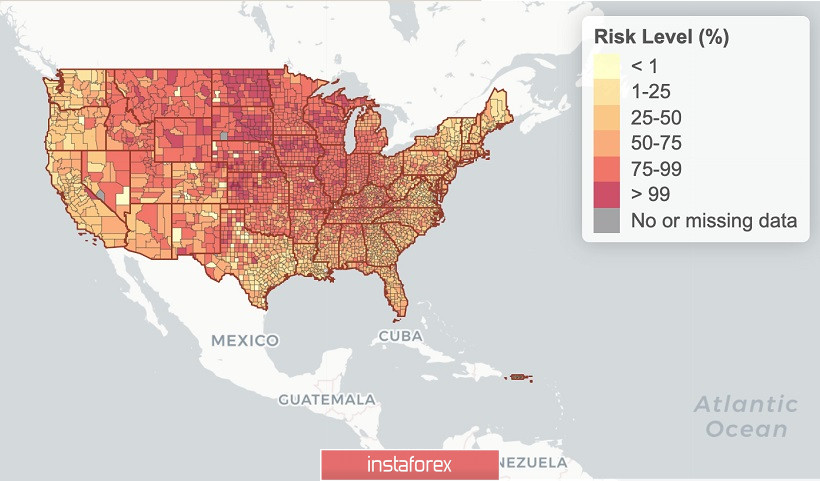The 2020 US presidential election finally ended: Donald Trump effectively put an end to the presidential race on Sunday. With certain reservations, Trump nevertheless admitted that the victory in the confrontation was won by his opponent, who, according to the Republican, "won through fraud." The world press extracted only a key message from this statement: the head of the White House admitted his defeat, which was obvious even before.
This suggests that the topic of the US elections will gradually leave the information space. Thus will again be replaced by news about COVID-19, which continues to bombard the world with new anti-records. And if until recently the focus was on Europe, now the focus of investors ' attention has shifted to the United States. In other words, we are at the start of a kind of "lockdown race". The coronavirus pandemic is a common problem for both the European Union and the US. But the dynamics of EUR/USD in the medium and long term will depend on how effective the countermeasures will be. Last summer, the Europeans showed a more successful result: EU countries began restarting their economies a little earlier than the US. And at the moment, the EU is also ahead of the curve.

According to the results of the first two weeks of November, key European countries can already talk about the first results of new lockdowns (quarantine measures were mainly tightened in the first days of this month). Although the second wave of the pandemic is still very far from being completely defeated, there are already some positive trends.
For example, in Germany, the upward curve of infections began to gradually smooth out. Last week, the daily increase in the incidence rate fluctuated in the range of 16,000 - 22,000, while on Sunday it fell to 10,000. Although the "weekend factor" may have played a role in this case, the overall dynamics indicate an improvement in the situation.
In France, the number of infections has dropped by about 16% over the past week compared to the end of October. According to the French Prime Minister, the peak load on the country's hospitals should come in mid-November (since the time gap between diagnosis and hospitalization is about 2 weeks), after which the situation should go down. The French authorities even started talking about the approximate dates for easing the quarantine – according to the head of government, this may happen as early as mid-December.
In Belgium, the daily growth rate decreased from 20,000 (before the lockdown) to the current 4,000. Similar dynamics were recorded in the Netherlands, the Czech Republic, and Ireland. The situation is more complicated in Spain – but there is also a positive trend. The daily increase in the number of cases there is decreasing slowly. In October the cases in the country fluctuated in the range of 22,000 - 25,000, now it has decreased to 14,000 - 17,000. The situation in Italy, on the contrary, remains at worst. The daily increase in the number of infected people is kept above the 30,000 mark. This fact forced the Italian authorities to significantly tighten quarantine restrictions in some regions of the country. But in general, the "European lockdowns" began to bear fruit. The overall situation has improved somewhat if we compare the current figures with the October figures.
In the US, the situation is getting worse almost every day. Last Friday, the daily new increase reported was 187,000. This indicator continues to hold above the 100,000 mark for almost two weeks. In November, 1.5 million new cases of COVID-19 infection were detected. According to many experts, if this trend continues, it threatens to collapse the health system. According to preliminary estimates, the daily increase in the infection will jump to 200,000 by December. Experts from George Washington University have warned that if stricter restrictions are not imposed, the number of coronavirus victims may exceed 2,000 people a day in a few weeks. Doctors, in turn, are sounding the alarm about overloaded hospitals, lack of medical staff, and general congestion.
On Monday, it became known that some states have decided to tighten quarantine restrictions. For example, in Michigan, universities, restaurants, and entertainment and sports venues will be closed from Wednesday. In the state of Washington, restaurants and fitness studios will be closed from the same day, and residents will not be allowed to gather in groups of more than 5 people in the open air. Almost complete lockdowns were introduced in New Mexico and Oregon. But the authorities of many states continue to ignore the warnings of doctors and do not impose strict quarantine measures. These include Florida, Nebraska, Georgia, Missouri, and Alaska. According to a number of specialized experts, these States will soon contribute to the overall statistics, and the daily increase in the number of cases will exceed the 200,000 mark on a stable basis.

All this suggests that the "coronavirus factor", which has been playing in favor of the dollar for several weeks, will turn against it. The US currency was used as a protective asset, while the euro became cheaper due to the introduction of lockdowns in European countries. Now the situation is gradually changing: lockdowns are bearing fruit in the form of a decrease in the incidence of diseases in the EU, while the US continues to register new daily anti-records.
This fundamental background contributes to the growth of EUR/USD. Judging by Monday's dynamics, traders intend to test the 19th figure in the very near future. The technical picture also talks about the priority of long positions: the price on the daily chart is between the middle and upper lines of the Bollinger Bands indicator, as well as above all the lines of the Ichimoku indicator and the Kumo cloud. All this suggests that longs can be considered for the pair – with the first goal of 1.1925 (the upper line of the Bollinger Bands on the same timeframe).
 English
English 
 Русский
Русский Bahasa Indonesia
Bahasa Indonesia Bahasa Malay
Bahasa Malay ไทย
ไทย Español
Español Deutsch
Deutsch Български
Български Français
Français Tiếng Việt
Tiếng Việt 中文
中文 বাংলা
বাংলা हिन्दी
हिन्दी Čeština
Čeština Українська
Українська Română
Română

